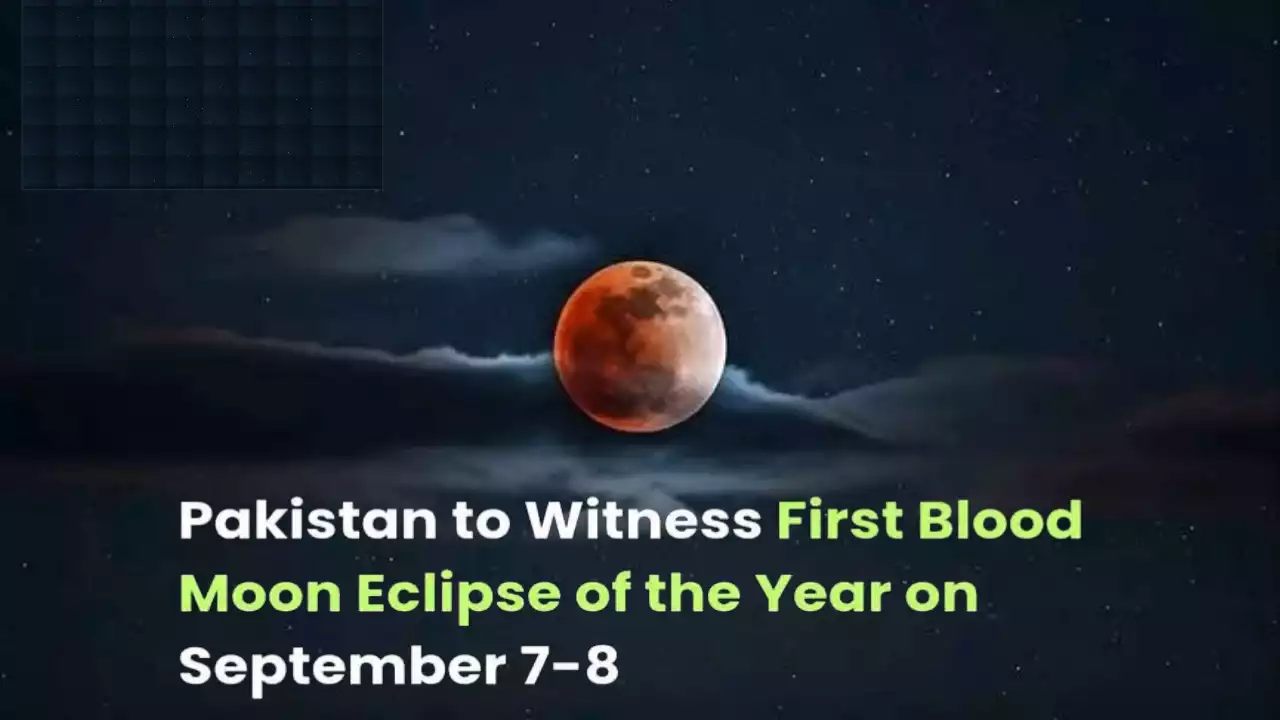Historic Blood Moon Eclipse September 2025: Pakistan’s First Celestial Spectacle
Pakistan prepares for an extraordinary astronomical event as the country witnesses its first-ever blood moon eclipse on September 7-8, 2025. This historic total lunar eclipse promises to deliver a stunning celestial display that will captivate millions of viewers across the nation and around the world.
The upcoming blood moon represents a rare astronomical phenomenon where Earth’s shadow completely covers the moon, causing it to appear deep red in color. This magnificent spectacle will be visible throughout Pakistan for over five hours, making it one of the longest lunar eclipses in recent years and a truly unforgettable experience for sky watchers.
What Makes This Blood Moon Special?
Pakistan’s First Historic Blood Moon
Pakistan will witness its first-ever Blood Moon during a total lunar eclipse on September 7-8, 2025, visible across multiple continents. This marks a significant milestone in Pakistan’s astronomical history, as millions of people will experience this celestial wonder for the first time in the country.
The eclipse gains its dramatic name from the moon’s distinctive red appearance during totality. When Earth blocks direct sunlight from reaching the moon, our planet’s atmosphere bends and filters the light, allowing only red wavelengths to reach the lunar surface. This creates the stunning blood-red glow that gives the phenomenon its memorable name.
Duration and Visibility Details
The penumbral eclipse will begin at 20:28 PST on 7 September 2025, marking the start of this extended celestial event. The total duration spans approximately 5 hours and 27 minutes, providing ample viewing opportunities for astronomy enthusiasts and casual observers alike.
The eclipse, which will also be visible in India, will be one of the longest in recent years, lasting a total of 1 hour and 22 minutes. During the peak totality phase, the moon will display its deepest red color, creating perfect conditions for photography and observation.
Complete Eclipse Timeline for Pakistan
Eclipse Phases and Timing
The September 2025 blood moon follows a precise timeline that sky watchers should note:
Penumbral Eclipse Beginning: The eclipse starts when the moon enters Earth’s outer shadow around 8:28 PM PST on September 7, 2025. During this phase, the moon appears slightly dimmer but maintains its normal color.
Partial Eclipse Phase: The dramatic visual changes begin as the moon enters Earth’s umbra, or main shadow. Viewers will notice a dark “bite” appearing on the moon’s edge, gradually growing larger.
Total Eclipse (Totality): The most spectacular phase occurs when the moon lies completely within Earth’s shadow. This totality phase lasts approximately 82 minutes, during which the moon transforms into its characteristic deep red color.
Ending Phases: The eclipse reverses through its phases, with the moon gradually emerging from Earth’s shadow until normal illumination returns.
Best Viewing Locations in Pakistan
The total lunar eclipse will be visible in most parts of Asia including India, Pakistan, Bangladesh, making it accessible to viewers across the entire country. Major cities including Karachi, Lahore, Islamabad, and Peshawar will all enjoy excellent viewing conditions.
Urban and rural areas alike provide suitable viewing opportunities, though locations with minimal light pollution offer the best photographic conditions. Rooftops, open fields, and elevated areas provide optimal viewing positions for this celestial spectacle.
Scientific Significance of Blood Moons
Understanding Lunar Eclipse Mechanics
A lunar eclipse takes place when the sun, earth, and moon align so that the moon passes into earth’s shadow. In a total lunar eclipse, the entire moon falls within the darkest part of earth’s shadow, called the umbra.
This astronomical alignment occurs only during full moons when Earth positions itself directly between the sun and moon. The precision required for total lunar eclipses makes them relatively rare events, particularly for any specific geographic location.
The Blood Moon Color Phenomenon
When the moon is within the umbra, it appears red-orange. Such lunar eclipses are sometimes called “Blood Moons” because of this colour. The red coloration results from Earth’s atmosphere acting like a lens, bending sunlight around our planet’s edges.
Blue light scatters more than red light in Earth’s atmosphere, similar to how sunsets appear red. During a lunar eclipse, this atmospheric filtering allows predominantly red wavelengths to reach the moon’s surface, creating the dramatic blood-red appearance that defines these special eclipses.
Photography and Observation Tips
Equipment Recommendations
While the blood moon remains visible to the naked eye throughout the eclipse, certain equipment enhances the viewing experience:
Binoculars: Standard 7×50 or 10×50 binoculars reveal surface details and enhance color intensity during totality.
Telescopes: Small telescopes provide detailed views of lunar features and the shadow’s progression across the moon’s surface.
Cameras: DSLR cameras with telephoto lenses capture stunning images of the eclipse phases. Tripods ensure sharp images during long exposures.
Photography Settings Guide
Successful blood moon photography requires specific camera settings that adapt to changing light conditions:
Early Phases: Use faster shutter speeds (1/60 to 1/125 second) with moderate ISO settings (400-800) when the moon appears bright.
Totality Phase: Extend exposure times (1-4 seconds) and increase ISO sensitivity (1600-3200) to capture the dimmed, red moon effectively.
Composition Tips: Include landscape elements, buildings, or trees to create compelling foreground interest in eclipse photographs.
Global Visibility and Cultural Impact
International Viewing Regions
According to DAG, the blood moon will be visible to over 87 percent of the world population across Europe, Africa, Asia, Australia and New Zealand. This widespread visibility makes the September 2025 eclipse a truly global event, connecting millions of observers across multiple continents.
The eclipse’s extensive visibility ensures that families, friends, and communities worldwide can simultaneously experience this natural wonder, creating shared memories and fostering international appreciation for astronomical events.
Historical and Cultural Perspectives
Blood moons have fascinated human cultures throughout history, inspiring myths, legends, and scientific curiosity. Ancient civilizations often interpreted lunar eclipses as significant omens, while modern astronomy explains the precise mechanics behind these captivating phenomena.
It’s no wonder ancient cultures saw blood moons as omens, given the moon’s dramatic transformation from its familiar silver glow to an otherworldly red appearance. Today, these events serve as powerful reminders of our place in the solar system and the dynamic nature of celestial mechanics.
Preparation and Safety Guidelines
Safe Viewing Practices
Unlike solar eclipses, lunar eclipses pose no safety risks for direct viewing. The moon’s reflected light remains safe for naked-eye observation throughout all eclipse phases, making blood moons family-friendly astronomical events.
Observers can look directly at the eclipsed moon without protective filters, though comfort items like lawn chairs, blankets, and warm beverages enhance the viewing experience during the multi-hour event.
Weather Considerations
Clear skies provide optimal viewing conditions for the blood moon eclipse. Pakistan’s September weather typically offers favorable conditions for astronomical observations, though local weather forecasts should guide final viewing plans.
Cloud cover represents the primary viewing obstacle, making weather monitoring important in the days leading up to the eclipse. Alternative viewing dates do not exist for lunar eclipses, emphasizing the importance of favorable weather conditions.
Educational and Community Opportunities
Learning Experiences
The September 2025 blood moon provides exceptional educational opportunities for students, families, and astronomy clubs. Schools and educational institutions can organize viewing events that combine practical observation with scientific learning about lunar cycles, Earth’s shadow, and atmospheric effects.
Community astronomy clubs often host public viewing events with telescopes, expert commentary, and educational materials that enhance public understanding of astronomical phenomena.
Building Astronomical Interest
Historic events like Pakistan’s first visible blood moon can inspire lasting interest in astronomy and space science. The accessibility and visual impact of lunar eclipses make them perfect introduction points for people of all ages to develop appreciation for celestial mechanics and scientific observation.







